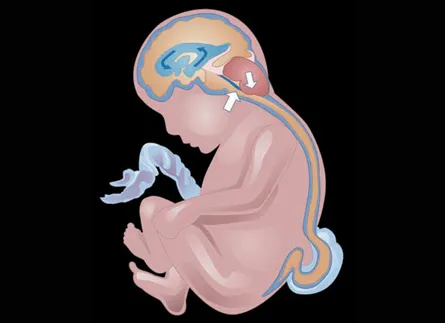Prenatal surgery may be preferable for spina bifida
Performing an operation preterm shows better results against the neural tube defect than waiting until the baby is born
Delicate surgery performed on a fetus months before birth can improve the health of children born with spina bifida, a devastating neural tube defect caused by an opening in the spine, a new study shows. By comparing children who got surgery before or after birth, researchers find that a preterm operation improves the likelihood that a child with spina bifida will be able to walk and lessens the risk of other neurological complications.
But these potential gains must be weighed against a greater risk of premature birth associated with surgery in the womb. The findings appear online February 9 in the New England Journal of Medicine.
The study focused on women carrying fetuses diagnosed with myelomeningocele, the most common and most severe form of spina bifida, in which the spinal cord bulges outside the spinal column. The condition can result in lifelong cognitive disabilities, fluid on the brain, bowel problems and paralysis. Typically surgeons operate on such babies within a few days of birth. During this procedure they insert the spinal cord back into its canal and seal off the opening with sutures. If successful, this limits fluid buildup in the brain and spinal cord and lessens the pull of the cord on the brain.
In the new trial, researchers identified 183 pregnant women who had a fetus diagnosed with myelomeningocele. Half were randomly assigned to undergo fetal surgery while the others were assigned to delay the surgery until after birth.
The new report documents the results of 158 of these operations, with roughly equal numbers from each group. Two children died in each group. By 12 months of age, 40 percent of babies in the preterm surgery group and 82 percent of babies that had gotten surgery as newborns needed and received shunts, surgically installed tubes that drain fluid off the brain to the abdomen.
Shunts can clog and become infected. “The expectation and hope of this trial is that by reducing the need for shunting, [preterm surgery] reduces the need for subsequent, multiple operations in the children,” says study coauthor Diana Farmer, a surgeon at the University of California, San Francisco Benioff Children’s Hospital.
The results also show that 42 percent of children who had undergone surgery in the womb were able to walk unassisted at age 3 compared with 21 percent of those who received the surgery postnatally. The two groups didn’t show marked differences in mental development.
The in utero surgery was done between 19 and 26 weeks of gestation. Earlier studies showed little benefit in doing the operation later in pregnancy, says study coauthor N. Scott Adzick, a surgeon at Children’s Hospital of Philadelphia. He says the preterm operation may stop fetal exposure to toxic factors in the amniotic fluid, lessen leakage of spinal fluid and stop the bulging spine from pulling on the brain stem and damaging it. These effects might mitigate fluid buildup and limit the need for shunting, he says.
But nearly four-fifths of babies that underwent surgery in utero were born prematurely (before 37 weeks) with 10 of 78 born before 30 weeks of gestation. Of the others, 15 percent were born prematurely. An average full-term pregnancy is about 40 weeks.
These trade-offs raise questions, say physicians Joe Simpson of Florida International University in Miami and Michael Greene of Massachusetts General Hospital in Boston, writing in the same NEJM issue. The study “is a major step in the right direction,” they note, but “the degree to which intrauterine repair will transform outcomes for fetuses with myelomeningocele remains unclear.”
Food fortification with folate has lessened the risk of neural tube defects, so-named because they appear in the neural tube, the embryonic predecessor to the brain and spinal cord. Women can reduce their risk of conceiving a child with these defects by taking folate or its synthetic version, folic acid, and vitamin B12 during their childbearing years. Even so, defects can still occur. “Sometimes prevention is not possible,” Adzick says. “Prenatal repair is not a cure for this birth defect, but it can reduce the need for shunting and improve the ability to walk at age 3.”








